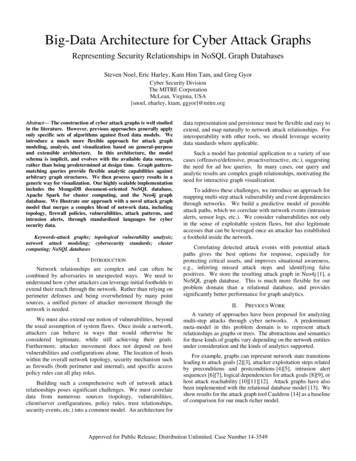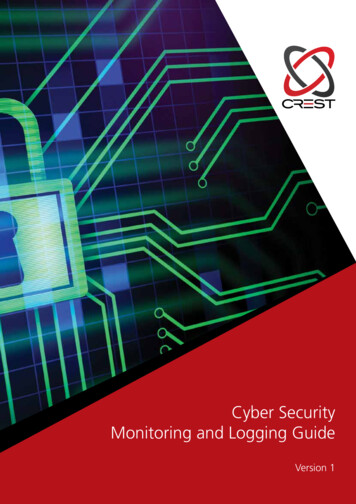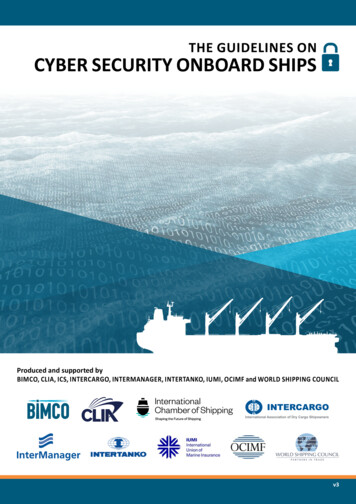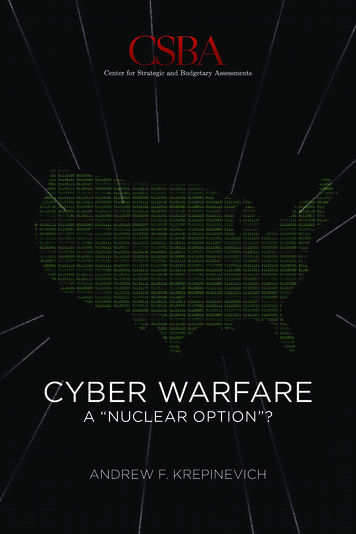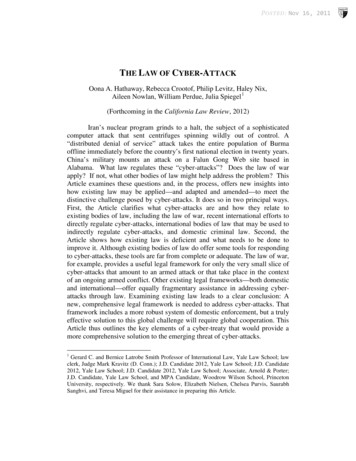
Transcription
Nov 16, 2011THE LAW OF CYBER-ATTACKOona A. Hathaway, Rebecca Crootof, Philip Levitz, Haley Nix,Aileen Nowlan, William Perdue, Julia Spiegel 1(Forthcoming in the California Law Review, 2012)Iran’s nuclear program grinds to a halt, the subject of a sophisticatedcomputer attack that sent centrifuges spinning wildly out of control. A“distributed denial of service” attack takes the entire population of Burmaoffline immediately before the country’s first national election in twenty years.China’s military mounts an attack on a Falun Gong Web site based inAlabama. What law regulates these “cyber-attacks”? Does the law of warapply? If not, what other bodies of law might help address the problem? ThisArticle examines these questions and, in the process, offers new insights intohow existing law may be applied—and adapted and amended—to meet thedistinctive challenge posed by cyber-attacks. It does so in two principal ways.First, the Article clarifies what cyber-attacks are and how they relate toexisting bodies of law, including the law of war, recent international efforts todirectly regulate cyber-attacks, international bodies of law that may be used toindirectly regulate cyber-attacks, and domestic criminal law. Second, theArticle shows how existing law is deficient and what needs to be done toimprove it. Although existing bodies of law do offer some tools for respondingto cyber-attacks, these tools are far from complete or adequate. The law of war,for example, provides a useful legal framework for only the very small slice ofcyber-attacks that amount to an armed attack or that take place in the contextof an ongoing armed conflict. Other existing legal frameworks—both domesticand international—offer equally fragmentary assistance in addressing cyberattacks through law. Examining existing law leads to a clear conclusion: Anew, comprehensive legal framework is needed to address cyber-attacks. Thatframework includes a more robust system of domestic enforcement, but a trulyeffective solution to this global challenge will require global cooperation. ThisArticle thus outlines the key elements of a cyber-treaty that would provide amore comprehensive solution to the emerging threat of cyber-attacks.1Gerard C. and Bernice Latrobe Smith Professor of International Law, Yale Law School; lawclerk, Judge Mark Kravitz (D. Conn.); J.D. Candidate 2012, Yale Law School; J.D. Candidate2012, Yale Law School; J.D. Candidate 2012, Yale Law School; Associate, Arnold & Porter;J.D. Candidate, Yale Law School, and MPA Candidate, Woodrow Wilson School, PrincetonUniversity, respectively. We thank Sara Solow, Elizabeth Nielsen, Chelsea Purvis, SaurabhSanghvi, and Teresa Miguel for their assistance in preparing this Article.
The Law of Cyber-AttackCONTENTSTHE LAW OF CYBER-ATTACK . 1I.WHAT IS A CYBER-ATTACK ? . 7A. Defining “Cyber-Attack”. 71. Government Conceptions of Cyber-Attack . 82. Recommended Definition . 10a. “A cyber-attack . . .” . 10b. “. . . consists of any action taken . . .” . 11c. “. . . to undermine the function . . .” . 12d. “. . . of a computer network . . .” . 15e. “. . . for a political or national security purpose.” . 153. Cyber-Attack, Cyber-Crime, and Cyber-Warfare Compared . 17B. Recent Cyber-Attacks . 221. Distributed Denial of Service Attacks . 222. Planting Inaccurate Information . 233. Infiltrating a Secure Computer Network . 24II.LAW OF WAR AND “CYBER-WARFARE” . 25A. Jus ad Bellum. 271. Governing Legal Principles . 272. Exceptions for Collective Security and Self-Defense . 293. Ad Bellum Necessity and Proportionality . 35B. Jus in Bello . 361. In Bello Necessity. 372. In Bello Proportionality . 373. Distinction . 38a. Who May Lawfully Be Targeted in Cyber-Attacks? . 40b. Who May Lawfully Carry Out a Cyber-Attack? . 414. Neutrality . 43III.OTHER LEGAL FRAMEWORKS GOVERNING CYBER-ATTACKS . 44A. Countermeasures . 45B. International Legal Regimes That Directly Regulate Cyber-Attacks . 481. The United Nations. 482. NATO . 503. Council of Europe. 514. Organization of American States. 532
The Law of Cyber-Attack5. Shanghai Cooperation Organization. 53C. International Legal Regimes That Indirectly Regulate Cyber-Attacks 541. International Telecommunications Law . 552. Aviation Law . 573. Law of Space . 594. Law of the Sea . 62D. U.S. Domestic Law. 63IV.NEW LAW FOR CYBER-ATTACKS . 67A. Battling Cyber-Attacks at Home . 681. Extend the Extraterritorial Reach . 682. Use Countermeasures To Increase the Options Available ToRespond to Cyber-Attacks . 69B. A Cyber-Attack Treaty . 701. Define Cyber-Attack and Cyber-Warfare . 712. International Cooperation on Evidence Collection and CriminalProsecution . 723
The Law of Cyber-AttackLast year, Iran’s nuclear program ground to a halt, the subject of asophisticated attack that sent centrifuges spinning wildly out of control. Theweapon? Stuxnet, a computer “worm” that appears to have many authors fromaround the world and was likely tested by Americans and Israelis at the IsraeliDimona complex in the Negev desert. 2A few months later, a so-called “distributed denial of service” attacktook the entire population of Burma offline immediately preceding thecountry’s first national election in twenty years. 3 It is widely believed that themilitary junta in Burma coordinated the attack to shut down the Internet, 4 butAmerican public officials have resisted blaming the attack on the government,even as they have criticized the election. 5In the summer of 2011, evidence emerged of a long-suspectedgovernment-sanctioned cyber-attack program in China. In late August, a statetelevision documentary aired on the government-run China Central Televisionappeared to capture an in-progress distributed denial of service attack byChina’s military on a Falun Gong Web site based in Alabama. 6 Thisrevelation followed on the heels of a report by the McAffee cyber-security2The seeds for this attack were apparently sewn well before 2010. The worm was firstdetected in 2008, when it infected networks around the world. It did no damage to mostsystems. At first, it was assumed that the attack, which appeared to target nuclear facilities inIran, was not successful. Yet in the fall of 2010 reports that Iran’s uranium enrichingcapabilities had been diminished. A Cyber-Missile Aimed at Iran?, The Economist ist.com/blogs/babbage/2010/09/stuxnet worm. See also Jonathan Fildes, Stuxnet Worm ‘Targeted High-Value IranianAssets,’ BBC News (Sept. 23, 2010, 6:46 AM), am J. Broad, John Markoff & David E. Sanger, Israeli Test on Worm CalledCrucial in Iran Nuclear Delay, N.Y. TIMES (Jan. 15, 2011), available athttp://www.nytimes.com/2011/01/16/ world/middleeast/16stuxnet.html. Stuxnet is the firstcomputer virus known to be capable of specifically targeting and destroying industrial systemssuch as nuclear facilities and power grids. Jonathan Fildes, Stuxnet Worm ‘Targeted .3Burma Hit by Massive Net Attack Ahead of Election, BBC NEWS (Nov. 4, 2010, 11:33 4See id.5See, e.g., Barack Obama, Remarks by the President and the First Lady in Town Hall withStudents in Mumbai, India (Nov. 7, 2010), available at -students-mumbai-india;Barack Obama, Statement by President Obama on Burma’s November 7 Elections (Nov. 7,2010), available at ctions.6Ellen Nakashima and William Wan, China’s Denials About Cyberattacks Undermined ByVideo Clip, WASH. POST (Aug. 24, 2011).4
The Law of Cyber-Attackcompany that a “state actor”—widely believed to be China—had engaged in ayears-long cyber-attack program aimed at a range of governments, U.S.corporations, and United Nations groups. 7What law governs these attacks? Some have referred to these andsimilar attacks as “cyber-warfare,” suggesting that the law of war might apply.Yet the attacks look little like the conventional warfare that the law of wartraditionally regulates. And if they are “warfare,” does that mean that victimsof such attacks might claim the right to use conventional force in selfdefense—potentially legally authorizing Iran, for example, to respond toStuxnet with a physical attack?This Article examines these questions and, in the process, offers newinsights into how existing law may be applied—and adapted and amended—tomeet the distinctive challenge posed by cyber-attacks. It does so in twoprincipal ways. First, the Article clarifies what cyber-attacks are and how theyrelate to existing bodies of law, including the law of war, 8 recent internationalefforts to directly regulate cyber-attacks, international bodies of law that maybe used to indirectly regulate cyber-attacks, and domestic criminal law.Second, the Article shows how existing law is deficient and what needsto be done to improve it. Although existing bodies of law do offer some toolsfor responding to cyber-attacks, these tools are far from complete or adequate.The law of war, for example, provides a useful legal framework for only thevery small slice of cyber-attacks that amount to an armed attack or that takeplace in the context of an ongoing armed conflict. Other existing legalframeworks—both domestic and international—offer equally fragmentaryassistance in addressing cyber-attacks through law. Examining existing lawleads to a clear conclusion: A new, comprehensive legal framework is neededto address cyber-attacks.The starting challenge in examining cyber-attacks may seem mundane,but is a critical starting point for any reform effort—that is, defining a “cyberattack.” The terms “cyber-attack,” “cyber-warfare,” and “cyber-crime” arefrequently used with little regard for what they are meant to include. This lackof clarity can make it all the more difficult to design a meaningful legalresponse. We therefore begin this Article in Part I by defining these terms. We7David Barboza & Kevin Drew, Security Firm Sees Global Cybersyping, N.Y. TIMES (Aug. 3,2011). This was not the first suggestion of a program of cyberattacks on private andgovernment actors by China. Computer attacks on Google that originated in China werebelieved to be part of a broader political and corporate espionage effort and prompted Googleto withdraw from the Chinese market. Ariana Enjung Cha & Ellen Nakashima, Google ChinaCyberattack Part of Vast Espionage Campaign, Experts Say, WASH. POST (Jan. 14, 2010).8For simplicity’s sake, this report refers collectively to jus in bello and jus ad bellum as the“law of war.”5
The Law of Cyber-Attackdefine “cyber-attack” as “any action taken to undermine the functions of acomputer network for a political or national security purpose.” We also explainthe difference between “cyber-attacks,” “cyber-warfare,” and “cyber-crime,”and describe three common forms of cyber-attacks: distributed denial ofservice attacks, planting inaccurate information, and infiltration of a securecomputer network.In Part II, we turn to examining how the law of war might governcyber-attacks. We parse the way the law of war, most of which was developedat a time when cyber-attacks were inconceivable, applies to this new zone ofconflict. We conclude that only a small slice of cyber-attacks are addressed bythe law of war. Most cyber-attacks do not rise to the level of an armed attackand do not take place in the context of an ongoing conflict—and thus are notsufficiently harmful to justify the use of armed force in response. The smallsubset of cyber-attacks that do rise to this level we call “cyber-warfare.” Thisdefinition is crucial because it limits the application of the “war” framework tothose actions that actually constitute “war” as a matter of international law. Wethen explore how the jus in bello regulations apply to cyber-attacks occurringin the context of an ongoing armed conflict.Because the law of war regulates only a small subset of cyber-attacks,in Part III we examine other existing legal regimes that could regulate cyberattacks. These include (1) the law of countermeasures, which governs howstates may respond to international law violations that do not justify uses offorce in self-defense; (2) international agreements and other cooperative effortsto directly regulate cyber-attacks; (3) international agreements that regulatemeans or locations of cyber-attacks, including telecommunications, aviation,space, satellites, and the sea; and (4) U.S. criminal law regulating cyberattacks. We conclude that, as with the law of war, these existing bodies of laweffectively address only a small part of the problem—leaving many harmfulcyber-attacks unregulated and uncontrolled by either domestic or internationallaw.Finally, in Part IV we consider how the problem of cyber-attacks mightbe more effectively addressed, offering recommendations for both domesticand international reforms. At the domestic level, states may expandextraterritorial reach of domestic criminal law and develop plans for thedeployment of customary countermeasures in response to cyber-attacks. Yet aneffective solution to this global challenge cannot be achieved by individualstates acting alone. It will require global cooperation. We therefore outline thekey elements of a cyber-treaty that would provide a more comprehensive andlong-term solution to the emerging threat of cyber-attacks.6
The Law of Cyber-AttackI.WHAT IS A CYBER-ATTACK ?The first challenge in evaluating how domestic and international lawmight be used to address cyber-attacks is to determine the nature and scope ofthe problem we face. Activities in cyberspace defy many of the traditionalcategories and principles that govern armed conflict under the law of war. ThisPart first offers a precise definition of “cyber-attack.” This step is not onlynecessary to the legal analysis that follows, but it also fills a gap in the existingliterature, which often uses the term without clarifying what it is meant toinclude and exclude. We then offer three categories of activities that fall withinthis definition, illuminating the extraordinary range of activities that fall undereven a carefully constructed and limited definition of “cyber-attacks.” Thisserves as a prelude to an analysis of what portion of cyber-attacks are governedby the law of war and other existing bodies of law.A. Defining “Cyber-Attack”For well over a decade, analysts have speculated about the potentialconsequences of a cyber-attack. The scenarios—ranging from a virus thatscrambles financial records or incapacitates the stock market, 9 to a falsemessage that causes a nuclear reactor to shut off 10 or a dam to open, 11 to ablackout of the air traffic control system that results in airplane crashes 12—anticipate severe and widespread economic or physical damage. While none ofthese scenarios has thus far occurred, numerous smaller incidents happenregularly. Nevertheless, there is no settled definition for identifying theseincidents as cyber-attacks, 13 much less as cyber-warfare. Only aftergovernments widely accept a definition will analysts be able to developcoordinated policy recommendations and will countries be able to actmultilaterally to address the growing threat posed by cyber-attacks. Afterdescribing some existing definitions, we offer a definition of cyber-attack thateffectively encompasses the activity that lies at the heart of the concerns raisedover cyber-attacks.9Duncan B. Hollis, Why States Need an International Law for Information Operations, 11LEWIS & CLARK L. REV. 1023, 1042 (2007).10Vida Antolin-Jenkins, Defining the Parameters of Cyberwar Operations: Looking for Lawin All the Wrong Places?, 51 NAVAL L. REV. 132, 140 (2008).11Barton Gellman, Cyber Attacks by Al Qaeda Feared; Terrorists at Threshold of UsingInternet as Tool of Bloodshed, Experts Say, WASH. POST, June 27, 2002, at A01.12General Accounting Office, Air Traffic Control: Weak Computer Security PracticesJeopardize Flight Safety (May 1998).13As distinct from cyber-crime. See Part I.B.7
The Law of Cyber-Attack1. Government Conceptions of Cyber-AttackThere have been two particularly prominent government-led efforts tounderstand the scope of the threat posed by cyber-attacks, one by the U.S.government and the other by the Russia- and China-led Shanghai CooperationOrganization. Perhaps not surprisingly, they have arrived at very differentunderstandings of the problem.The U.S. military has yet to offer an official definition of cyber-attackor cyber-warfare. 14 Instead, the Joint Chiefs of Staff have defined forms ofwarfare closely related to cyber-warfare. For example, the Joint Chiefs explainthat “information warfare” includes operations “to influence, disrupt, corrupt,or usurp adversarial human and automated decision making while protecting[one’s] own.” 15 They define a sub-class of information warfare, computernetwork warfare, as:[T]he employment of Computer Network Operations (CNO)with the intent of denying adversaries the effective use of theircomputers, information systems, and networks, while ensuringthe effective use of our own computers, information systems,and networks. These operations include Computer NetworkAttack (CNA), Computer Network Exploration (CNE), andComputer Network Defense (CND). 1614The Congressional Research Service does provide an official definition but it is notparticularly specific: Cyber-warfare is “warfare waged in cyberspace. It can include defendinginformation and computer networks, deterring information attacks, as well as denying anadversary’s ability to do the same. It can include offensive information operations mountedagainst an adversary, or even dominating information on the battlefield.” Steven A. Hildreth,Cyberwarfare, CONGRESSIONAL RESEARCH SERVICE, 16 (June 19, 2001). The Department ofDefense’s Strategy for Operating in Cyberspace utilizes the term “cyber threats” rather thancyber-attacks to describe the threats to cyberspace. See U.S. DEP’T OF DEF., DEPARTMENTOF DEFENSE STRATEGY FOR OPERATING IN CYBERSPACE 2 (July 2011) [hereinafter DODSTRATEGY].15JOINT CHIEFS OF STAFF, U.S. DEP’T OF DEF., JOINT PUB. 3-13, INFORMATION OPERATIONS, atix (Feb. 13, 2006). [hereinafter JP 3-13] (listing five IO methods: (1) electronic warfare; (2)computer network operations, including computer network attacks; (3) psychologicaloperations; (4) military deception; and (5) operational security).16JEFFREY CARR, INSIDE CYBER WARFARE 176 (2010). Additionally, numerous commentatorsand scholars have offered their own similar definitions. Government security expert Richard A.Clarke defines cyber-war as “actions by a nation-state to penetrate another nation’s computersor networks for the purposes of causing damage or disruption.” RICHARD A. CLARKE &ROBERT K. KNAKE, CYBER WAR: THE NEXT THREAT TO NATIONAL SECURITY AND WHAT TODO ABOUT IT 6 (2010). Former National Security Advisor and Central Intelligence Agency8
The Law of Cyber-AttackSimilarly, the U.S. National Research Council defines cyber-attack as“deliberate actions to alter, disrupt, deceive, degrade, or destroy computersystems or networks or the information and/or programs resident in ortransiting these systems or networks.” 17 Although the objective-baseddefinitional approach taken by the United States is preferable, the complexityof these definitions partially explains the lack of uniformity within thegovernment. Moreover, the definition fails to distinguish between a simplecyber-crime and a cyber-attack. A simpler, uniform definition would avoidambiguity, overlap, and coverage gaps; facilitate a cleaner delineation betweencyber-attack and cyber-crime; and promote greater inter-agency cooperation.The Shanghai Cooperation Organization—a security cooperation groupcomposed of China, Russia, and most of the former Soviet Central Asianrepublics, as well as observers including Iran, India, and Pakistan—hasadopted a much more expansive means-based approach to cyber-attacks. TheOrganization has “express[ed] concern about the threats posed by possible useof [new information and communication] technologies and means for thepurposes [sic] incompatible with ensuring international security and stability inboth civil and military spheres.” 18 It defines an “information war” as “masspsychologic[al] brainwashing to destabilize society and state, as well as toforce the state to take decisions in the interest of an opposing party.” 19Moreover, it identifies the dissemination of information harmful to “social andpolitical, social and economic systems, as well as spiritual, moral and cultural(“CIA”) Director Michael Hayden defines cyber-war as the “deliberate attempt to disable ordestroy another country's computer networks.” Tom Gjelten, Extending the Law of War r.org/templates/story/story.php?storyId 130023318.17COMM. ON OFFENSIVE INFORMATION WARFARE, ET. AL., NAT’L RES. COUNCIL,TECHNOLOGY, POLICY LAW AND ETHICS REGARDING U.S. ACQUISITION AND USE OFCYBERATTACK CAPABILITIES (WILLIAM A. OWENS, ET. AL. EDS., 2009) [hereinafter NRCREPORT].18Agreement between the Governments of the Member States of the Shanghai CooperationOrganization on Cooperation in the Field of International Information Security, 61st plenarymeeting (Dec. 2, 2008) [hereinafter Shanghai Cooperation Agreement]. The distinctionbetween this interpretation and that of the United States is understandable in light of MatthewWaxman’s analysis of strategic differences in the cyber-attack context. As Waxman notes,“major state actors in this area are likely to have different views on legal line drawing becausethey perceive a different set of strategic risks and opportunities.” Matthew C. Waxman, CyberAttacks and the Use of Force: Back to the Future of Article 2(4), 36 YALE J. INT’L L. 421, 45859 (2011).19Shanghai Cooperation Agreement, Annex I, at 209.9
The Law of Cyber-Attackspheres of other states” as one of the main threats to information security. 20Hence the Shanghai Cooperation Organization appears to have adoptedan expansive vision of cyber-attacks to include the use of cyber-technology toundermine political stability. Commentators fear that this almost unrestricteddefinition represents an effort to justify censorship of political speech on theInternet. 21 This concern is particularly salient in light of recent governmentefforts to suppress political organizing using new media in Iran, Egypt, andelsewhere.The distance between these two government-led understandings ofcyber-attacks only serves to make clear the importance of specifying a cleardefinition of the problem to be faced. The next subsection takes on this task.2. Recommended DefinitionIn this Article, we adopt a narrow definition of cyber-attack, one meantto focus attention on the unique threat posed by cyber-technologies:A cyber-attack consists of any action taken to undermine the functionsof a computer network for a political or national security purpose.This subsection discusses each aspect of this definition to explain the reasoningbehind the language and to clarify which activities it encompasses.a. “A cyber-attack . . .”Implicit in this term is the requirement that the conduct must be active:either offense or active defense. 22 Active defense includes “electronic countermeasures designed to strike attacking computer systems and shut downcyberattacks midstream.” 23 Governments are likely to employ both active andpassive defenses, and so it is crucial that the legal boundaries of both are wellunderstood. 2420Id. at 203.See, e.g., Tom Gjelten, Seeing the Internet as an ‘Information Weapon’, NPR.com (Sep. 23,2010), Id 130052701; see also infraI.B.2.e.22Measures of passive defense against cyber-attacks, such as virus scanning software orfirewalls, are outside the scope of this definition.23CARR, supra note 16, at 46.24The U.S. government currently utilizes both active and passive defenses. See DODSTRATEGY, supra note 14.2110
The Law of Cyber-Attackb. “. . . consists of any action taken . . .”A cyber-attack’s means can include any action—hacking, bombing,cutting, infecting, and so forth—but the objective can only be to undermine ordisrupt the function of a computer network. In this sense, we follow the U.S.objective-based approach rather than the means-based approach of theShanghai Cooperation Organization.There is no consistent strategy under international or domestic law forclassifying different types of warfare. Some types of warfare are defined bytheir means, which is most often a weapon. Examples include kinetic warfare,biological warfare, chemical warfare, nuclear warfare, intelligence-basedwarfare, network-based warfare, 25 and guerilla warfare. Other types of warfareare defined by their objectives. “Objective” here means the direct target, ratherthan the long-range purpose. Examples include information warfare,psychological warfare, command and control warfare, electronic warfare, andeconomic warfare.Because we define cyber-attack according to its objective, any meansmay be used to accomplish a cyber-attack. For this form of warfare or attack, adefinition limited by objective rather than means is superior for three reasons.First, and most important, this type of definition is simply more intuitive.Using a computer network in Nevada to operate a predator drone for a kineticattack in Pakistan is not a cyber-attack; rather, it is technologically advancedconventional warfare. Using a regular explosive to sever the undersea networkcables that carry the information packets between continents, on the otherhand, is a cyber-attack. 26 This view is consistent with that offered by the U.S.Department of Defense, which has identified kinetic attack as a strategy in“cyber offensive operations.” 27Second, the objective-based approach is logical. Warfare traditionallyfunctions in four domains—land, air, sea, and space—each of which is25This is distinct from “network warfare,” which is defined as “the employment of ComputerNetwork Operations (CNO) with the intent of denying adversaries the effective use of theircomputers, information systems, and networks, while ensuring the effective use of our owncomputers, information systems, and networks.” Id. at 176. Network-based warfare is any typeof warfare that utilizes networks. Note a similar distinction between intelligence-based warfare(which describes the means) and information warfare (which describes the objective).26See Antolin-Jenkins, supra note 10, at 138 (“[K]inetic weapons are certainly part of thecyber arsenal.”).27Joint Chiefs of Staff, National Military Strategy for Cyberspace Operations 15 (December2006). A National Research Council report on “cyber offensive operations” excluded kineticattacks on computer networks for the purposes of the report, but acknowledged that suchattacks were realistic forms of cyber attack. NRC REPORT, supra note 17, at 12-19.11
The Law of Cyber-Attackaddressed by one of the full-time armed services. 28 With the rise of cyberwarfare, strategists have identifi
define “cyber-attack” as “any action taken to undermine the functions of a computer network for a political or national security purpose.” We also explain the difference between “cyber-attacks,” “cyber-warfare,” and “cyber-crime,” and describe three common forms




